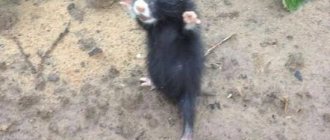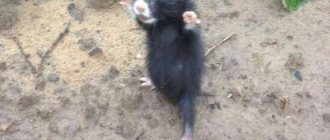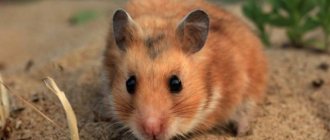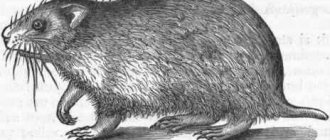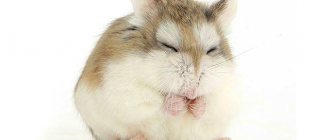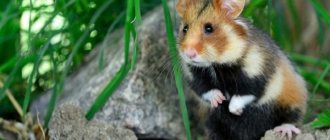And it looks like a funny animal... The carbysh differs from the domestic hamster in its size and character. Moreover, his character is not for the better. Wild hamsters are very aggressive. Watching the video, the thought arises that they completely lack a sense of fear and the instinct of self-preservation. Take a look for yourself:
In addition to the “standard” coloring, which you see in the photo in the title of the article, they can be completely black. In any case, it is a malicious crop pest. The field hamster stores up to 20 kg of vegetables and fruits for the winter, robbing fields and vegetable gardens. But we will talk about the problems that wild hamsters cause to owners of fields and gardens a little later. And now, as one smart person said, “You need to know the enemy by sight.”
He reminds me of someone. Some kind of Kung Fu Panda.
What does karbysh look like?
Externally, the karbysh is similar to a domestic hamster, but much larger. The length of adult individuals reaches 32 cm and weight 700 g. The muzzle is elongated, with round ears. A small thick tail up to 8 cm in length is covered with hard fibers. Short strong legs end in long claws. The incisors are well developed and grow throughout life. Like domestic hamsters, they have cheek pouches to carry food.
The fur of adult animals is harsh and brown in color. There are light spots on the side of the front paws. The animal's abdomen is black. Sometimes there are completely black animals with light spots on the ears, neck and paws.
Wild hamsters are common inhabitants of forest-steppes. They often settle near water and swim well. In Russia, wild hamsters have inhabited the area from the Smolensk region to the Perm region; in the south, their habitat reaches the Black and Caspian Seas.
Despite their rapid reproduction and harm to humans, the animals are protected in some European countries.
Forest hamsters are cautious and wary animals
Appearance
First of all, it is worth noting that this animal belongs to hamsters, being a representative of a rather harmful family. As you can see in the photo, the carbysh animal really looks like other rodents of this species.
- Its color is quite bright, even beautiful.
- The back is yellowish-brown, the belly is black, and the sides are decorated with large white spots. At the same time, the coat is short, but thick and pleasant to the touch, very soft.
- The ears are quite massive and stand out sharply on a neat head.
- The paws are quite wide with thin, sharp claws, which allows the carbysh to dig deep holes in which it will live, store supplies for the winter and raise offspring.
The karbysh is one of the largest hamsters - its weight can reach 750 grams! At the same time, the body is quite dense, compact, up to 35 centimeters long.
Where does it live and what does it eat?
They live in burrows. They dig passages with a diameter of about 10 cm and a length of up to 5 m. The depth of the hole reaches 1.5 m. Each hole has at least 2 exits. They have a nesting area and a special grain storage facility, where the animals make supplies for the winter. In winter, the animals are less active and fall into shallow hibernation.
Plant food forms the basis of the animals' diet, but they can also hunt small vertebrates. They happily eat insects and their larvae. Their usual diet:
- Cereals – barley, wheat, millet.
- Root vegetables - potatoes, carrots.
- Grass, legumes, corn.
- Frogs, mice, lizards.
- Insects and their larvae.
These animals are most active at dusk.
Forest hamsters are loners, do not tolerate proximity to their relatives and violently expel them from their territory. The only exception is the mating period.
The reserves that the animal begins to make in early autumn are transferred to the burrow in the cheek pouches.
Forest inhabitants are very aggressive. When they see an opponent, they stand on their hind legs, make threatening sounds and literally pounce on him. Their sharp teeth can cause serious wounds. Such clashes sometimes end in death.
In the wild, their enemies are:
Lifestyle
The common hamster is nocturnal.
It settles throughout the region, but prefers places with high humidity. It can be found in forests, gardens, vegetable gardens, fields, and loves country houses and their extensions such as cellars and hangars. Karbysh, who do not have a herd instinct, set up their burrows at a distance from each other. The burrow, up to 2 m deep, has vertical and oblique passages, nesting and storage compartments.
The forest hamster feeds on plant and animal food. Its diet includes cereals, seeds, legumes, root vegetables, greens, insect larvae, even small animals like frogs, lizards, and chicks.
The breeding season for Karbysh begins in March-April, depending on weather conditions. During this period, the female can bear three times, 9-12 cubs per litter.
Does the black animal hibernate? Partially. In winter, he actually sleeps most of the time, but periodically wakes up to have a snack. Therefore, in the fall, Karbyshi make large reserves for the cold season. There are potatoes, seeds, and vegetables here. A lover of food, the common hamster is capable of dragging up to 13 kg of food into its hole. Moreover, he arranges the food according to type, carefully. As for fears, the animal has been noted to have a fear of water. Ordinary hamsters live in the wild for about 4 years, tamed - up to 6.
Harm and benefit to humans
The gastronomic preferences of karbysh lead to the fact that the animals often settle near humans: near fields cultivated and planted with grain crops, near granaries, in gardens and vegetable gardens.
Outwardly, karbysh are quite cute animals, but having settled next to a person, they are capable of destroying a significant part of the crop already at the stage of seed germination, eating young shoots. In addition, they are very aggressive and, in case of danger, can attack the offender, even a person. They are not intimidated by the size of the enemy.
Forest hamsters are wild animals and are not suitable for keeping at home.
In this, forest hamsters are similar to rats. Like all wild rodents, they are carriers of diseases.
Conservation status
The number of the species has declined sharply over the past 20 years and continues to decline, but mainly only in the west and north of its range. Western European countries have adopted national programs for the conservation of this species.
The common hamster is protected in France, Belgium, the Netherlands, Germany, Poland, and Belarus.
In 2009, it was included in the Red Book of Ukraine, and by 2012, in the Autonomous Republic of Crimea, the animal was causing significant damage to the agriculture of the peninsula, including suburban farms.
On the territory of the Russian Federation it is protected in 5 constituent entities of the federation. A decrease in the number of the species has also been noted in other regions of the European part of Russia.
The hamster population is stable in Kazakhstan and Siberia, where during years of population growth it can cause harm to agriculture.
In recent years, the number has increased in the Azov district of the Rostov region, in the Krasnodar Territory, as well as in the Crimea, where the hamster also causes significant damage.
Methods of dealing with wild animals
Pets do not hunt them due to their rather large size and aggressiveness of the animals.
There are several ways to fight the forest hamster:
- Installation of traps. The hole has several passages, and traps will have to be set at each passage. They must be tied, as a wild hamster is strong and can easily drag them away.
- Flooding the hole with water. Before this, you need to find all the passages of the animal and wait for where it will come out.
- Placement of poisoned bait on the site. Rat poison will do just fine.
- Using homemade noise devices.
- Installation of industrial ultrasonic repellers.
If there is a dog on the site, then it will be a salvation from carbysh
The big problem is that forest hamsters are very cautious, and their numbers are quickly restored. Do not try to catch carbish and keep it as a pet hamster, they are very aggressive and do not habituate.
Prevention of pest occurrence
If you do not want carbysh to start up on your site, you should get a dog or a rat-catcher cat. These animals will do an excellent job of protecting against dangerous rodents. After all, they perceive them exclusively as tasty and desirable prey.
Of course, if you choose this method, then the use of poisons is out of the question - your pets may well be poisoned by them.
Karbysh, forest hamster
This animal began to annoy us in the late nineties. Previously, these animals simply did not exist in our area.
And when they appeared, no one could determine which of the known species of the rodent order they belonged to. There was no doubt that these were rodents, because their manifestation of love for onions, peas, beets, and potatoes growing in vegetable gardens knew no boundaries!
Seeing and examining the robber turned out to be difficult, since he leads a nocturnal lifestyle. And if anyone managed to see it in the early morning hour, then the speed of movement of the beast did not make it possible to accurately determine either its size or shape.
Over time, its descriptions were supplemented by the qualitative adjective “black” and the noun “beast”. Subsequently, the adjective underwent a change in gender, “black”, and the noun “beast” was replaced by the word “bitch”. I will not cite other combinations of strong words, although I sincerely understand the people from whose lips these phrases burst out from the bottom of their hearts. I'll show you a few photos.
The hostess planted cabbage. She watered, nurtured, and one morning it turned out that this beast had gnawed a good third of the young, established seedlings.
And it’s okay, I ate it! I cut off the tops and threw them away! I didn't like the cabbage! How to save the harvest?
We made various fences, low barriers from branches, pieces of cellophane, and covered the seedlings with grass. It helped, but you always have to remember that some of the seedlings will be destroyed. The beast does not touch the grown heads of cabbage.
At the dacha there was a carbysh, biting the cat so badly that it was impossible to save it
We arrived at the dacha and got to work. I was working not far from the fence, a neighbor from the other line walked past, stopped and called out:
- Hello! Don’t you have any karbysh? - Whom? – I didn’t understand, even forgetting to say hello. - Yes, karbysh. They have already defeated everyone here, haven’t reached your line yet, or what?
For several seconds I stood in a stupor, trying to understand who she was talking about. Then, smiling stupidly, she admitted:
- Oh, I don’t even know who it is. Moles, or what? “No, what kind of moles are there?” the woman waved her hands. – It’s a real attack, such pests.
And then for about twenty minutes I listened to her attentively and my hair just didn’t stand on end.
“You’re on the third line, and we’re further on, on the sixth,” the neighbor said, “we’ve got so many of them already, we don’t know how to fight!” It started with the fact that Tamara, my neighbor, somehow heard some sounds under her porch, like meowing. One day, two, then she asked her husband to look, and there was a nest with a karbysh and ten babies in it. And they are so beautiful, Tamara felt sorry, and she began to feed them. They grew up, ran away and began to spoil everything, gnawing - from seedlings to garlic, they devour everything! - Wow! – I was amazed. - And they eat garlic?! - Both onions and garlic, they eat everything. And what they don’t eat, they drag into reserves for the winter. And they give birth to their little rats three times a year and 10-15 at a time! And they are quite large in size, 30 centimeters in length. - Wow! – I was impressed, imagining it. “You’ll be scared if you see this.” “It’s better to be scared and not go near them,” the neighbor nodded. “They are very angry, they are not afraid of people, they jump and bite. And they bite very hard, leaving straight wounds. Moreover, they carry all sorts of infections. - Ugh! – I winced and sighed. – Should I get another cat? - What kind of cat are you? – the woman waved her hands. “The neighbors’ cat was bitten by these little fishes so much that he was barely taken to the veterinary clinic. But in vain - they tried to resuscitate him, but they couldn’t.
Just in case, I called out, and she came running from somewhere deep in the garden.
“Oh,” I sighed with relief, “after this horror with the cat, I was afraid for my beauty.” I see the others, but she’s not there. “Well, you can rest assured about the dog, and such a big one,” the neighbor assured, “the karbysh will be afraid of it.” Maybe they won’t even come to your site. “We have four dogs,” I said joyfully. - Oh, well then you won’t have any karbysh! – the neighbor smiled. - Most likely, no - even the hedgehog ran away from us, now he lives in a neighboring area, we only see him behind the fence. “We need to rent your dogs so that we can catch and scare away all these pests.”
That's where we parted. We promised to come visit with our two favorites - a mongrel and a half-husky. Both of them consider themselves hunters, especially the second one. Apparently, the husky mother’s genes overpower the husky father’s, and the hunting instinct manifests itself much stronger than the desire to run in a harness.
1) If you see a nest with some babies under the porch, it’s better to figure out who it is, and only then help their mother raise the brood. 2) The more dogs there are, the less likely it is that harmful karbysh will appear. ))
Work on mistakes.
To my shame, I didn’t know who karbysh were and had never come across this name. It turned out that these are the most ordinary hamsters... But not at all those cute creatures that live in cages, peacefully eat, sleep and spin their wheels. This is a natural variant - very voracious, terribly prolific and wildly aggressive, a carrier of dangerous infections and a destroyer of all plantings.
A couple of weeks later, this story unexpectedly received a continuation (you can read HERE
).
Dear channel readers!
I will be sincerely grateful to you for your appreciation of my efforts and your opinion. Please don't forget to click on the heart if you liked the story or found the recipe useful. And please subscribe to my channel - there will be many more. Special deep gratitude for the repost.
Method of dealing with carbysh
My colleague suggested a method of fighting. He lives in a private house on the outskirts of Kazan and had exactly the same problems with karbysh as I did. Currently, the animal has disappeared, and according to him, this happened for two reasons. 1. There are a lot of dogs in the village. And dogs are the enemies of karbysh.
2. The entire village began to catch these animals in an organized manner using rat traps.
The trap sizes are arbitrary. In the version of the trap in the photo, dimensions are 35x15x15 cm. The principle of operation is visible in the photo.
The hook holds the door open. When the animal removes the bait, the hook slides off, and the door slams shut under its own weight and under the influence of the force of the rubber bands.
An important element of the trap is the latch. When closing the door, it should lock the door in the closed position.
Otherwise, the hamster can easily get out of the cage. Verified.
During the summer season, 5-6 animals are caught in a trap placed in my garden. It happens that any signs of the presence of rodents disappear. But, as soon as a raid on the next bed is detected, the trap located near the bed, as a rule, is triggered - in the morning you can see a night robber who has fallen for the onion bait.
In conclusion of my story, I want to finally dispel unconfirmed rumors.
One of the versions is about crossing.
How true is the assumption that hamsters crossed with rats or moles?
Personally, I don't believe in this. Man has repeatedly tried to crossbreed animals belonging to different species. Just remember that a mule is a hybrid of a horse (mare) and a donkey (male). A hinny is a hybrid of a donkey and a stallion. But the mule and the hinny are barren! No matter how hard you try, you cannot fool nature! And yet, how do we understand this word “karbysh”? From the explanatory dictionary of V.I. Dahl, it follows that this is a hamster, a field animal with cheek pouches. That is, “karbysh” is not the scientific name of the animal, but a folk, outdated, colloquial name.
Hamsters belong to the subfamily of mammals of the rodent order.
Includes about 390 species throughout the planet.
Body length from five to 50 cm, tail from barely noticeable to exceeding body length.
Distinctive features: the chewing surface of the cheek teeth is tuberous; the tubercles on the lower and upper teeth are located in two longitudinal rows (the main difference from other mouse-like rodents). Hamsters are characterized by bare cheek pouches; in some species they are very voluminous. All rodents have highly developed incisors (one pair in each jaw) and grow throughout their lives. Enamel covers only the front surface of the incisors, and the back is softer dentin. In this regard, self-sharpening of the incisors occurs.
It turns out that my neighbor, the black hamster (or forest hamster), is not a mutant at all, but one of the representatives of a large species of hamsters that came from another, southern habitat. Scientists know about all these animals. And if suddenly, due to incredible circumstances, there is a risk of extinction of the black forest hamster, it will immediately be listed in the Red Book, appropriate work will be organized, turning the destroyer of fields and vegetable gardens into an endangered species that requires protection.
But that won't happen. All rodents are very fertile. They have several litters per year, with many (8-15) young in each. Highly prolific species are characterized by unstable numbers: years of extreme abundance are followed by years of almost complete extinction over vast areas. I think our hamster is no exception. And his appearance in our territories indicates that he liked the climate of our region. After all, the climate tends to change. So let's continue protecting our beds!
Reproduction
All rodents are especially prolific. Karbysh is no exception. Common hamsters breed in March and April. During the season, a female can give birth to about three broods. Each time 8-15 cubs are born. How to deal with them? Karbysh without timely control measures will not leave a trace of crops in the garden. Therefore, it is necessary to take action immediately.
Extermination by water
This is a fairly simple and effective way to expel black forest hamsters from your summer cottage. Find rodent holes, then use high pressure to fill them with water. The exits from the holes must be covered with something heavy so that the rodent cannot get out. Rags and other things are useless in this case. This rodent has great strength and can easily push them out. Use big stones. You can also put a bucket of water.
All exits must be closed. If you miss any of them, this extermination technique will be useless. The forest hamster will crawl out of the hole and will continue to safely destroy garden plantings.
Mechanical devices
In the fight against pests, mechanical devices will not be superfluous. A trap for carbysh should be taken with an arc one, designed for catching small fur-bearing animals.
The charged device is placed at the horizontal entrance to the animal’s home. Since the karbysh is capable of dragging away the trap, it should be securely fixed to the ground. Some people fight rodents with traps, similar to mousetraps, only larger in size. This trap, like the previous one, should be secured. To make the animal fall into the trap faster, you can add water to the hole. In this case, the hamster will jump out and immediately fall into the trap.
Homemade traps are used to catch the animal. To make it, take a box with a lid that fits tightly. Two rubber bands are attached to the lid. They will press her. Place a spreader or stick under the lid. Bait is placed inside the box. The rodent runs into the box and eats the bait. At this time the lid slams behind him. Instead of a box, it is more advisable to use a metal cage. Traps and traps are the best remedies for hamsters. With them, the question of how to breed carbysh will be resolved within a short time.
Loosening holes
Another way to exterminate a black pest on your site. True, it is more expensive and labor-intensive. To implement it, you will need a garden shovel, maximum effort and patience. Use a shovel to dig up rodent holes. This way you can catch live animals. It's up to you to decide what to do with them - kill them or take them away from the site.
Unfortunately, this method does not provide a 100% guarantee that you will catch all the rodents on the site. It is simply impossible to dig up the entire garden. Moreover, forest hamsters dig out entire labyrinths underground.
Character
The hamster is the most aggressive and evil rodent. If other species of its family prefer not to appear in front of humans, then this one will rush into battle at the first opportunity. Moreover, these animals rush at dogs that are several times larger than themselves.
Even if you look at what a hamster eats, you can immediately recognize its evil character. For example, if a male meets a female not during mating, he will bite her to death. If, during the mating process itself, several contenders line up for the process, then the weaker ones rarely manage to survive.
It is impossible not to note the love of animals for territorial division. Males can control land up to 12 hectares, females - a little less. If another animal enters the territory of one hamster, a fight ensues. Moreover, the owner of the land will defend himself as zealously as possible.
Thus, a meeting with a steppe hamster does not bode well. The only way to make a good pet out of him is to bring a very small individual into the house, which will not know how its relatives live.
Trap
This is an old, proven product that is used to catch rodents both in the house and in the garden. A device must be installed at each hole. And put bait inside it - grain, nuts. In pursuit of food, the rodent falls into a trap and can no longer get out of it.
There are two types of traps on sale. Some are designed to catch rodents, others are designed to completely destroy them. Which one is better is up to you to decide.
By the way, this remedy does not always work. Forest hamsters are very cunning and dexterous. Seeing that there is a dubious device at the exit of the hole, they can bypass it, digging a hole out in another place. Therefore, traps are not considered the most effective means of controlling wild rodents.
Rodent protection
Voracious animals can seriously ruin your harvest. If you notice that they have become a habit in your area, immediately take the necessary measures to get rid of troglodytes.
- Method one. Having found a hole, place an arc trap at its entrance, tying it to a peg (so that a physically strong hamster cannot escape). Sedentary animals, Karbysh rarely leave their homes, so this method is very effective for the complete extermination of rodent pests. You can use an ordinary rat trap with a latch on an elastic band, which will work when the animal tries to take the food.
- Method two. Place poisoned baits on and around your legs. The most effective are Rat Death, Storm, Finale, Klerat, Mortorat. As the rodent eats part of the portion, immediately replenish it.
Karbysh has a habit of walking along the same path every time. Take this point into account when catching. He also cannot stand the heat at all: if a rodent gets caught in a trap, spending a day in the sun will kill him. Try an ultrasonic repeller too.
To speed up the process of identifying the location of the pest hole, coat your garden with sticky flour. This way you can trace the trajectory of the fugitive. However, do not try to catch it manually, since the animal can become aggressive in moments of danger, especially if it is driven into a corner. In this, his habits are similar to those of a rat. Karbysh is characterized by cunning and caution. Alarmed, he begins to growl, grind his teeth, and inflate his cheek pouches. Then he stands on his hind legs and rushes at his enemy. The bites of a wild hamster leave lacerations on the body, but the worst thing is an infection that gets into the blood. These animals are carriers of various diseases. You can drive away the beast by pouring water on it.
Some gardeners use a biological control method - poisoning the fruit and thus transmitting the poison to the entire brood. But this method is considered prohibited. Another option to get rid of the animal is to set dogs on its trail. But cats are unlikely to be able to cope with a rather large animal.
Fence the fruits on the site with a metal mesh - in combination with the two listed methods. You can purchase products to combat Karbysh in grocery stores; almost all of them have them in stock. When you begin baiting activities, warn your neighbors in the area, since the agile rodent can run into their property, bypassing the fences.
In this article I will talk about the wild carbysh hamster. It is also called the forest or garden hamster. I will list the similarities and differences between the animal and the domestic hamster. I will tell you about living conditions, nutrition, distribution and reproduction, as well as about the proximity to humans and the possibility of taming.
Pesticide
Poison against hamsters
If you have black forest hamsters in your garden, you can use bait for them. The modern market of pesticides offers a variety of poisonous agents for such pests.
From the experience of gardeners, only a few effective means have gained the most popularity:
The poison is mixed with food and water. The poison is then placed near the hamster's hole. For a rodent to try this treat, it must be mixed with a grain mixture, nuts, seeds, and vegetable trimmings.
The poison should be spread in dry weather. In the rain, the poison loses its properties. Poison bait is laid out throughout the area - near the hamster holes and along the paths.
Also, do not forget that such products are dangerous to humans. When laying them around the area, use protective gloves and a mask.
Spreading
The common hamster is common in meadow and forest-steppes, as well as in the mixed-grass steppes of Eurasia from Belgium to Altai and Northern Xinjiang.
In Russia, the northern border of the range goes:
- from Smolensk north of Rzhev to Yaroslavl, Kirov and Perm;
- in the north of the Perm region it reaches 59°40′ N. sh.;
- in the Trans-Urals it goes through Yekaterinburg, crosses the Irtysh north of Tobolsk and the Ob in the Kolpashevo region, from where it goes to Krasnoyarsk.
The eastern border is formed by the Minusinsk steppe, where the hamster penetrated relatively recently.
The southern border runs:
- along the Azov and Black Sea coasts approximately to Gagra;
- covers the western Ciscaucasia, goes around the deserts and semi-deserts of the eastern Caspian region and the Volga-Ural interfluve from the north;
- crosses the Volga in the Astrakhan region.
Then it goes to Kazakhstan, where it goes approximately 47° N. w. to the lower reaches of the river Sarysu, covers the northern part of Betpak-Dala, the central and northeastern parts of the Kazakh hillocks, the valleys of the river. Ili and Karatal, the foothill areas of the northern and eastern Tien Shan, the Alakol and Zaisan basins and along the border of western Altai reaches the right bank of the Yenisei near the village. Beya.
Folk remedies
You have a forest hamster in your garden, then folk remedies for fighting it will be of help. We bring to your attention the most effective and proven:
- Take regular ash, pour it into holes and dust the paths made by rodents. As you know, ash is an alkali. As it moves, it will eat away at the skin of its paws. The forest hamster will lick it off. Once inside, this substance corrodes the stomach, resulting in the death of the rodent.
- Grind several wine corks into small crumbs. Pour aromatic oil over them, mix this mixture well and place it near the hole. The oily aroma is very attractive to rodents. A rodent simply cannot refuse such a fragrant treat. The plugs that get inside the stomach begin to swell, resulting in an obstruction in the intestines, and the rodent dies.
- Mix alabaster with wheat flour. Place a couple of spoons of seven near the mink. Place a container of water nearby. After eating the dry mixture, the rodent will certainly want to drink water. By reacting with liquid, alabaster turns into cement. Therefore, the probability of death of the rodent is one hundred percent.
Poisons
Another option for how to combat carbysh in your garden plot is to use a special rodent poison. The bait is placed at all entrances to the hole. The bait should be replenished periodically.
Popular and effective options:
- "Waratah". It is a grain-based granule. The active ingredient is brodifacoum. The death of rodents occurs 4-10 days after eating bait in the diet for one day. The advantage of the product is its low cost.
- "Clairat." The product is a rodenticide that contains both an active substance (brodifacoum) and a bait. Death occurs within 3-7 days after a single meal.
- "Storm". Wax briquettes with the active ingredient flocumafen. Preparations based on it are among the most powerful pest control agents. Fatal from a single ingestion, death occurs 4-8 days after ingestion. The downside of this product is toxicity, so precautions must be taken when working with it.
Ultrasonic extermination
Ultrasonic repellers are becoming more and more popular every year. This method of struggle has several significant advantages:
- A loyal method that does not poison rodents in the garden. The forest hamster simply runs away.
- Such a device will help you get rid of all rodents on the site at the same time.
- It is also convenient that you can turn on such a device only when necessary, namely at night, when rodents crawl out in search of food.
The disadvantages of this product include high cost and harmful effects on humans and pets.
Several devices of this type are in greatest demand:
There are cheaper options, but they should not be used due to their low frequency and short range.
Ultrasonic repellers
Another effective tool that helps remove carbys from the area is a rodent repeller. This method of pest control is the most humane and safe. The device emits high-frequency ultrasonic waves, the frequency of which changes at a speed of 60 times per second. For rodents, the sound produced becomes unbearable, and they try to move to another territory without a hostile sound signal. The following devices are especially popular:
- "Typhoon". Can be used over an area of up to 220 m. Operates with a wide sound beam. Works in two modes: silent and sound. The first is used in residential premises, the second is more effective and is used where people do not live.
- "Grad". It works silently. Emits simultaneously sound and ultrasonic waves. There is a built-in flickering beam.
- "Electrocat" The rodent repeller acts not only with sound waves, but also with light flashes. There is a special irritating signal that has the most effective effect on rodents.
To achieve better results in the fight against underground pests, some gardeners bury an ultrasonic device in the ground and turn it on. According to them, karbysh leave the garden plot in a short time.


